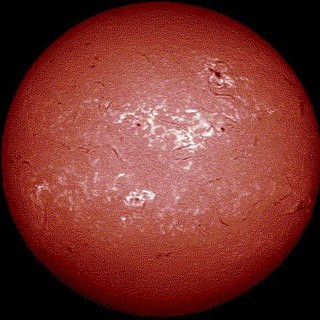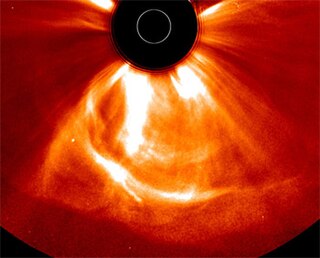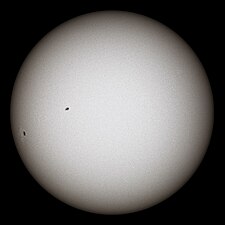
A corona is the outermost layer of a star's atmosphere. It consists of plasma.

X-ray astronomy is an observational branch of astronomy which deals with the study of X-ray observation and detection from astronomical objects. X-radiation is absorbed by the Earth's atmosphere, so instruments to detect X-rays must be taken to high altitude by balloons, sounding rockets, and satellites. X-ray astronomy uses a type of space telescope that can see x-ray radiation which standard optical telescopes, such as the Mauna Kea Observatories, cannot.

A solar flare is an intense localized eruption of electromagnetic radiation in the Sun's atmosphere. Flares occur in active regions and are often, but not always, accompanied by coronal mass ejections, solar particle events, and other solar phenomena. The occurrence of solar flares varies with the 11-year solar cycle.

A chromosphere is the second layer of a star's atmosphere, located above the photosphere and below the solar transition region and corona. The term usually refers to the Sun's chromosphere, but not exclusively.

A coronal mass ejection (CME) is a significant ejection of magnetic field and accompanying plasma mass from the Sun's corona into the heliosphere. CMEs are often associated with solar flares and other forms of solar activity, but a broadly accepted theoretical understanding of these relationships has not been established.

The Solar and Heliospheric Observatory (SOHO) is a European Space Agency (ESA) spacecraft built by a European industrial consortium led by Matra Marconi Space that was launched on a Lockheed Martin Atlas IIAS launch vehicle on 2 December 1995, to study the Sun. It has also discovered over 4,000 comets. It began normal operations in May 1996. It is a joint project between the European Space Agency (ESA) and NASA. SOHO was part of the International Solar Terrestrial Physics Program (ISTP). Originally planned as a two-year mission, SOHO continues to operate after over 25 years in space; the mission has been extended until the end of 2025, subject to review and confirmation by ESA's Science Programme Committee.

A prominence, sometimes referred to as a filament, is a large plasma and magnetic field structure extending outward from the Sun's surface, often in a loop shape. Prominences are anchored to the Sun's surface in the photosphere, and extend outwards into the solar corona. While the corona consists of extremely hot plasma, prominences contain much cooler plasma, similar in composition to that of the chromosphere.
In magnetohydrodynamics (MHD), shocks and discontinuities are transition layers where properties of a plasma change from one equilibrium state to another. The relation between the plasma properties on both sides of a shock or a discontinuity can be obtained from the conservative form of the MHD equations, assuming conservation of mass, momentum, energy and of .

In solar physics, a coronal loop is a well-defined arch-like structure in the Sun's atmosphere made up of relatively dense plasma confined and isolated from the surrounding medium by magnetic flux tubes. Coronal loops begin and end at two footpoints on the photosphere and project into the transition region and lower corona. They typically form and dissipate over periods of seconds to days and may span anywhere from 1 to 1,000 megametres in length.
Coronal seismology is a technique of studying the plasma of the Sun's corona with the use of magnetohydrodynamic (MHD) waves and oscillations. Magnetohydrodynamics studies the dynamics of electrically conducting fluids - in this case the fluid is the coronal plasma. Observed properties of the waves (e.g. period, wavelength, amplitude, temporal and spatial signatures, characteristic scenarios of the wave evolution, combined with a theoretical modelling of the wave phenomena, may reflect physical parameters of the corona which are not accessible in situ, such as the coronal magnetic field strength and Alfvén velocity and coronal dissipative coefficients. Originally, the method of MHD coronal seismology was suggested by Y. Uchida in 1970 for propagating waves, and B. Roberts et al. in 1984 for standing waves, but was not practically applied until the late 90s due to a lack of necessary observational resolution. Philosophically, coronal seismology is similar to the Earth's seismology, helioseismology, and MHD spectroscopy of laboratory plasma devices. In all these approaches, waves of various kind are used to probe a medium.

A nanoflare is a very small episodic heating event which happens in the corona, the external atmosphere of the Sun.

The Bastille Day solar storm was a powerful solar storm on 14-16 July 2000 during the solar maximum of solar cycle 23. The storm began on the national day of France, Bastille Day. It involved a solar flare, a solar particle event, and a coronal mass ejection which caused a severe geomagnetic storm.

The solar storm of 2012 was a solar storm involving an unusually large and strong coronal mass ejection that occurred on July 23, 2012. It missed Earth with a margin of approximately nine days, as the equator of the Sun rotates around its own axis with a period of about 25 days.

Solar phenomena are natural phenomena which occur within the atmosphere of the Sun. These phenomena take many forms, including solar wind, radio wave flux, solar flares, coronal mass ejections, coronal heating and sunspots.

Barbara June Thompson is an American solar physicist. She is a scientist at Goddard Space Flight Center where she researches coronal mass ejections and the dynamics of coronal structures. Thompson was the project scientist for NASA's Solar Dynamics Observatory mission through development and early flight.

Supra-arcade downflows (SADs) are sunward-traveling plasma voids that are sometimes observed in the Sun's outer atmosphere, or corona, during solar flares. In solar physics, arcade refers to a bundle of coronal loops, and the prefix supra indicates that the downflows appear above flare arcades. They were first described in 1999 using the Soft X-ray Telescope (SXT) on board the Yohkoh satellite. SADs are byproducts of the magnetic reconnection process that drives solar flares, but their precise cause remains unknown.
Jiong Qiu (邱炯) is a Chinese-born American astrophysicist who won the Karen Harvey Prize for her work in solar flares.
Solar radio emission refers to radio waves that are naturally produced by the Sun, primarily from the lower and upper layers of the atmosphere called the chromosphere and corona, respectively. The Sun produces radio emissions through four known mechanisms, each of which operates primarily by converting the energy of moving electrons into electromagnetic radiation. The four emission mechanisms are thermal bremsstrahlung (braking) emission, gyromagnetic emission, plasma emission, and electron-cyclotron maser emission. The first two are incoherent mechanisms, which means that they are the summation of radiation generated independently by many individual particles. These mechanisms are primarily responsible for the persistent "background" emissions that slowly vary as structures in the atmosphere evolve. The latter two processes are coherent mechanisms, which refers to special cases where radiation is efficiently produced at a particular set of frequencies. Coherent mechanisms can produce much larger brightness temperatures (intensities) and are primarily responsible for the intense spikes of radiation called solar radio bursts, which are byproducts of the same processes that lead to other forms of solar activity like solar flares and coronal mass ejections.

Dr Natchimuthuk "Nat" Gopalswamy is an Indian American Solar physicist. He is currently a staff scientist at the Heliophysics Division of NASA’s Goddard Space Flight Center.
Gordon Dean Holman is an emeritus research astrophysicist at the National Aeronautics and Space Administration’s (NASA’s) Goddard Space Flight Center in Greenbelt, Maryland. His research mostly focused on obtaining an understanding of high-energy radiation from astronomical objects. This radiation cannot be observed from Earth’s surface, but is observed with instruments on satellites launched to orbits above Earth’s atmosphere. It is primarily emitted by high-energy electrons interacting with ions. These electrons also emit radiation at radio frequencies which is observed from Earth’s surface. Consequently, these observations from space and radio telescopes provide a view of hot gas and energetic particles in the Universe that could not otherwise be obtained. Holman has specialized in the interpretation of these observed emissions to determine the origin and evolution of this hot gas and energetic particles. He has been described as "not just a theorist, he also looks at the data".
















